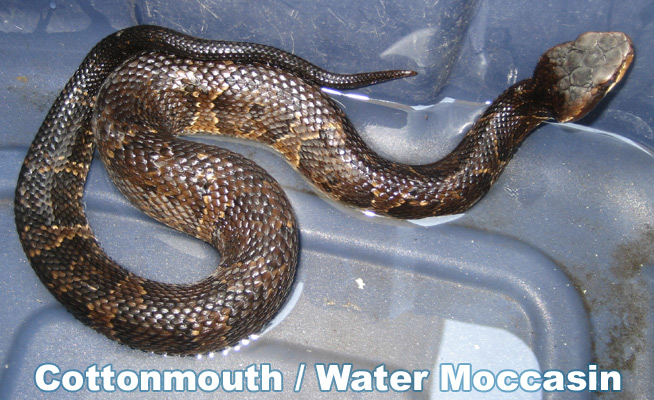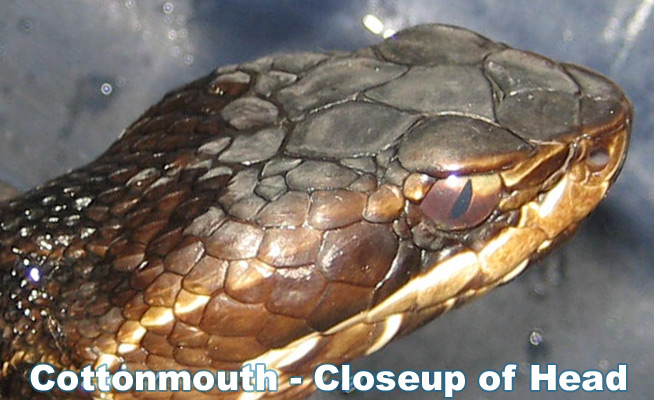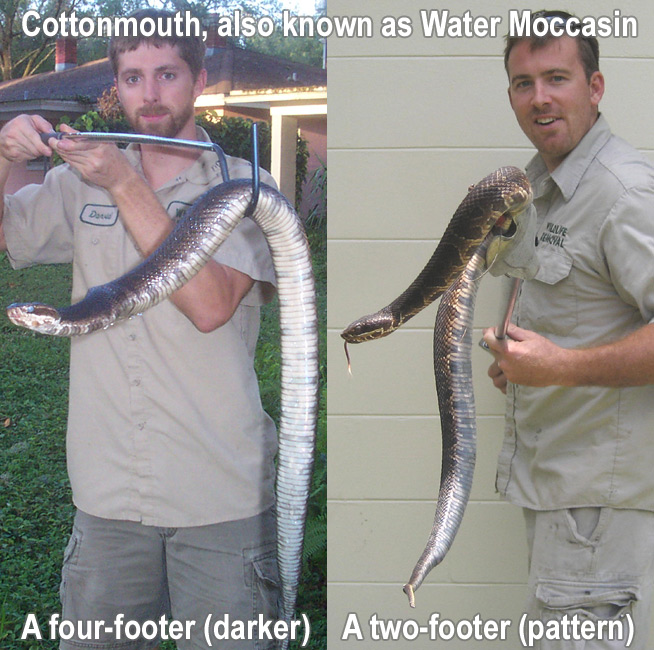First off, I want to clear any confusion. A Water Moccasin and a Cottonmouth are the same species of snake, Agkistrodon piscivorus “hooked-tooth fish-eater”. I'm not sure which name is more popular. The moccasin name is more of a
native name, I believe, because these snakes live in water and have a color pattern similar to native shoes. And the cottonmouth name comes from the fact that the inside of the snake's mouth is white, and when threatened, it often opens
its mouth and displays the white inside, and of course, cotton is white. For additional information on this snake, see my Cottonmouth Snake Page.

This moccasin is a juvenile, only about two feet long. The color patterns are more vibrant in the young, with browns and a distinct pattern. As they age, they get darker and darker,
until by the time they are 4-5 foot adults, they look like dull black slugs.

Here's a closeup of the head of a young moccasin. You can see the color patterns, and the elliptical pupil. This snake is not very attractive overall, but the young ones look pretty nice. But don't get too close, of course.
The Water Moccasin snake is a snake that is found primarily in the southern part of the United States. The Water Moccasin can be found in states such as Florida, Southern Virginia and in Eastern parts of Texas. The Water Moccasin is a semi-aquatic snake and can be found in fields, forests, marshes, swamps, drainage ditches, lakes ponds and rivers. They often burrow in sandy banks and in rotting logs near the edge of the water. They can be seen sunning themselves on the banks of these areas in the heat of the day. Even though they can be seen sunning themselves during the day, they are the most active at night.
Water Mocassins can reach up to 4 feet long but can grow up to 6 feet long if there is a lot of food available. The color of the Water Moccasin is a dark greenish brown color (almost black) with a pale belly. The snake has dark vertical lines by each nostril and a pale snout and chin. The Water Moccasin and the black racer are often mistaken for each other even though the racer is not venomous. What is unique about the Water Moccasin is that it is in the family of pit vipers and because of this they have heat sensors in their eyes and in their noses. This gives them a type of night vision that is useful in catching prey at night.
When Water Moccasins feel threatened they can be very scary looking. They coil their body up and opens its mouth wide so that they predator can see its enormous fangs. The inside of the mouth is very white, hence the name Water Moccasin. However, Water Moccasins are not easily provoked and will leave you alone unless they are cornered. The venom of the Water Moccasin is very toxic and kills its victims by causing a hemorrhage at the site where the poison is injected. In other words, this snake’s venom makes it harder for blood to clot and the victim will bleed out or die from internal bleeding. Snakes do not like to strike unless they absolutely have to and know that they will make contact because it takes several weeks for their venom sacks to replenish and they are left without protection.
The Water Moccasin is a carnivore and will eat anything that it can overpower whether it is warm or cold blooded. Their diet mainly consists of fish, birds, other snakes, frogs, rodents, baby alligators, lizards and small turtles. The Water Moccasin kills its prey by injecting a small amount of poison into the victim and then holds it in its mouth until the prey dies and will then eat the prey head first. If the prey should escape after the strike, this snake can always track it by scent until the victim finally dies. The Water Moccasin likes to take its time while it eats which is unusual for a snake, but is probably due to the prey being dead. The Water Moccasin does not have very many predators; in fact most predators leave this snake alone because its venom is so poisonous. The predators of the Water Moccasin snake are king snakes, herons, largemouth bass and humans although humans are very wary around this snake.
Water Mocassin snakes breed in the spring and only ovulate every other year. The female Water Moccasin will have a gestational period of three to four months. After the babies come to term the female snake will give live birth up to 12 young which will be completely independent as soon as they are born. Baby Water Moccasins do not need the protection or the hunting skills of their mothers because they have evolved the unique ability to flick their pink tongues and trick frogs and other creatures into thinking it is a worm.

Here is a comparison of two moccasins, on the left is a four-footer, and on the right is a two-footer (held really close to the camera). You can see that the older one has less of a pattern, they belly is white, and the body is darker, almost black.
But the young one has more browns and tans and more of a pattern. Both can deliver a deadly strike.
Many people want to know how to kill a Water Moccasin, but you don't need to. The
best way to get rid of Water Moccasins is to simply leave them alone. You can also
use a Water Moccasin trap to catch them - that's one of the best ways for how to
remove Water Moccasin. For more information, go to my
Snake Removal - How to Get Rid of Snakes home page.
If you need Water Moccasin removal in your city, I have friends that I have
personally trained in these cities and over 100 other places: